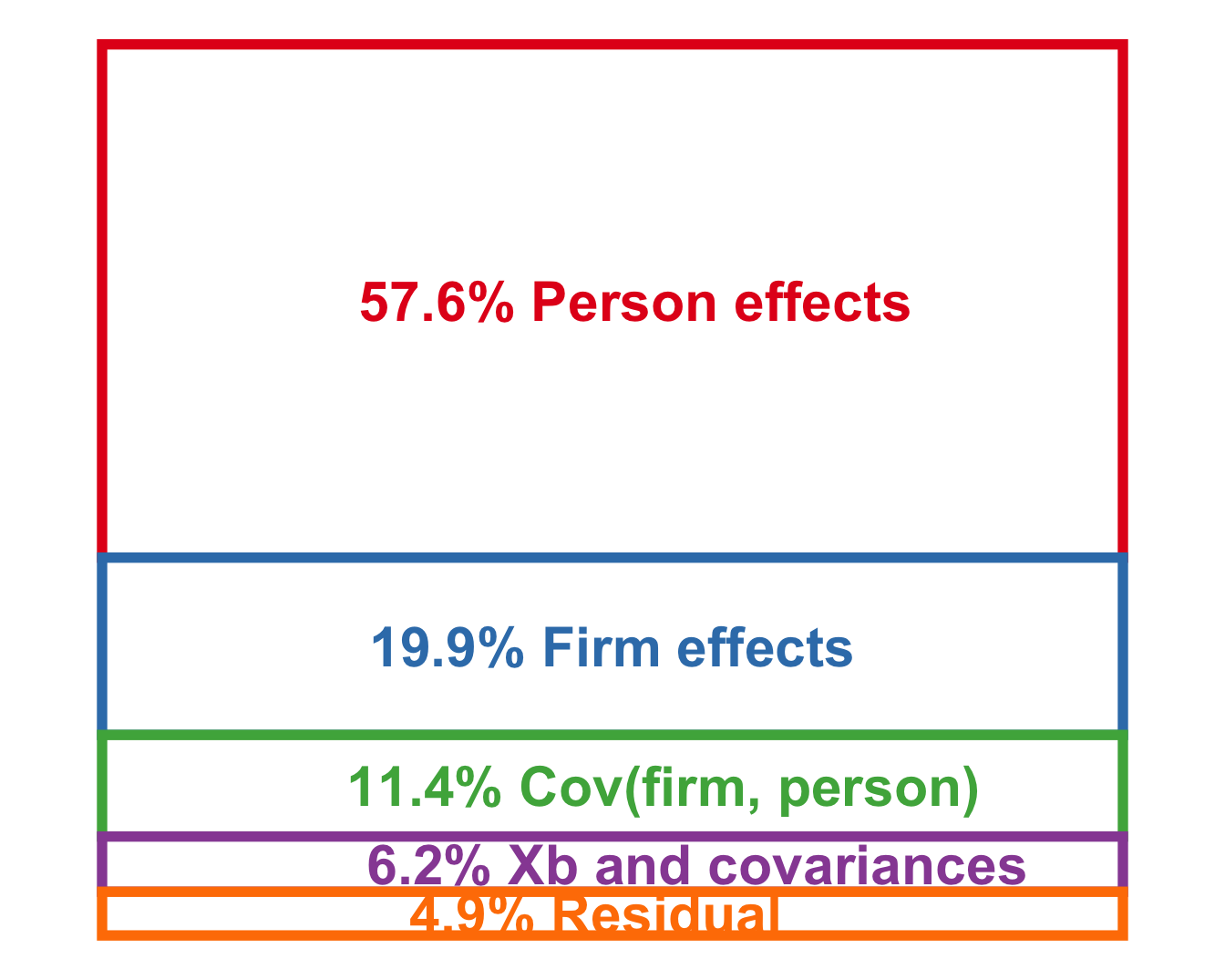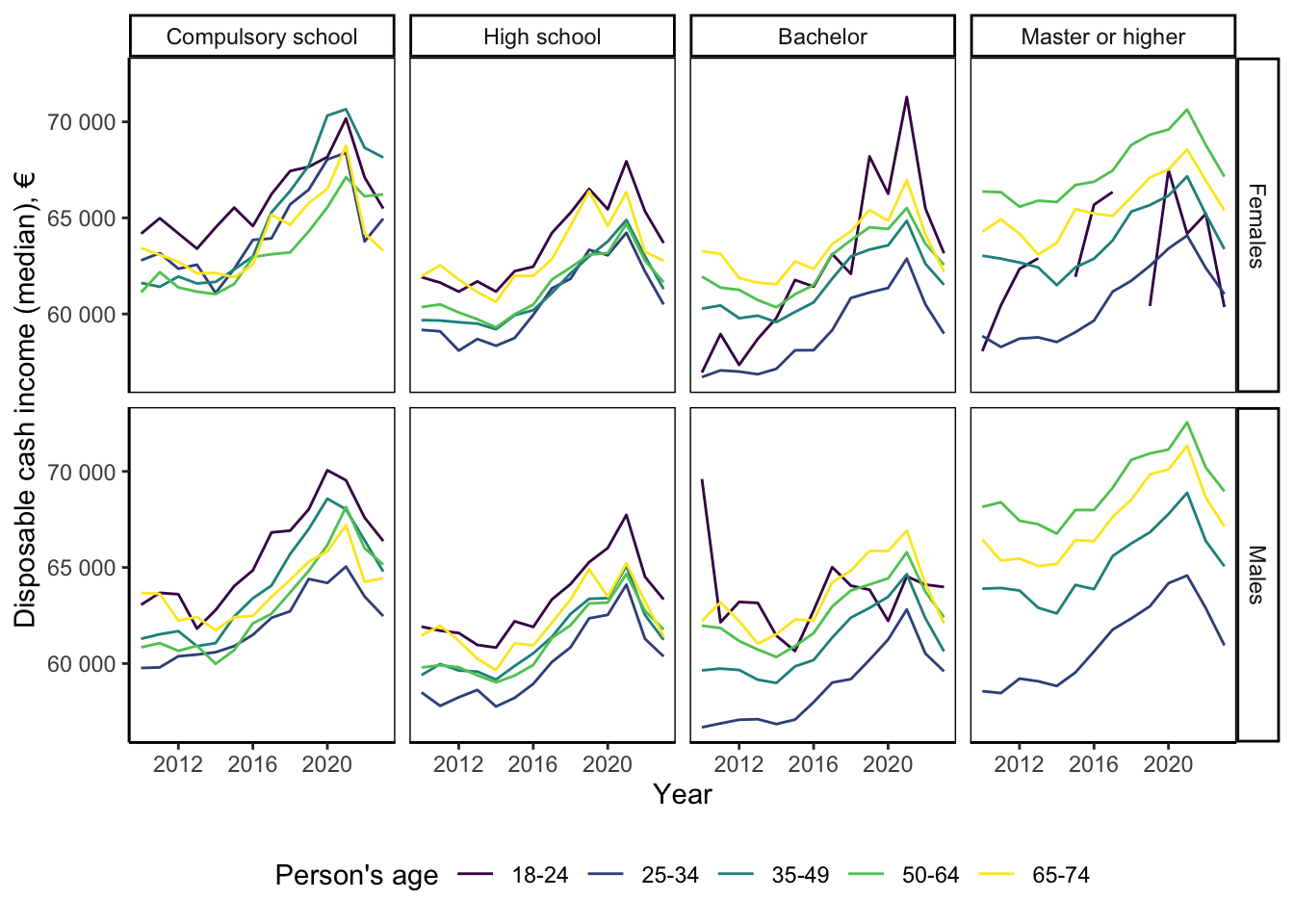
5. Wage setting
KAT.TAL.322 Advanced Course in Labour Economics
- Why do wages differ between workers?
- Compensating differentials
- Bargaining power of firms and workers
- Imperfect information about productivities and jobs
- Relative contributions of different sources to overall wage inequality
Stylised facts
Wage dispersion
The central question of today’s lecture is wage dispersion, i.e., the fact that different workers get different wages on the labour market. We want to start understanding the determinants of wage dispersion.
We haven’t yet considered worker heterogeneity and their human capital. This will be the topic of next lecture. However, you might already guess that large part of the variation can be attributed to such worker difference.
At the same time, worker differences do not account for all variations in observed wages. For example, the above figure shows the differences between income of high- and low-earning individuals holding age, educational qualification and gender fixed. The difference in annual disposable income can be as high as €70K.
Variation by occupation

One possible explanation that we will consider are differences in job characteristics. For example, we can in the figure above that medical doctors is a highest paid occupation with almost €55/hour wage. Whereas cleaning personnel and general helpers are among the least paid workers with a little more than €13/hour wage. It is clear that level of skills necessary to do different jobs varies, so there is clearly room for human capital and differences in individual skills to explain some of this variation. You can also see that even within the broad category of healthcare professionals, there is still substantial variation in wages.
You can also think that different jobs have different requirements and/or difficulty levels. So, one possibility is that jobs that are more difficult and require more of specialized skills, should compensate their workers a little more. This is the idea behind compensating differentials theory that we will cover shortly today.
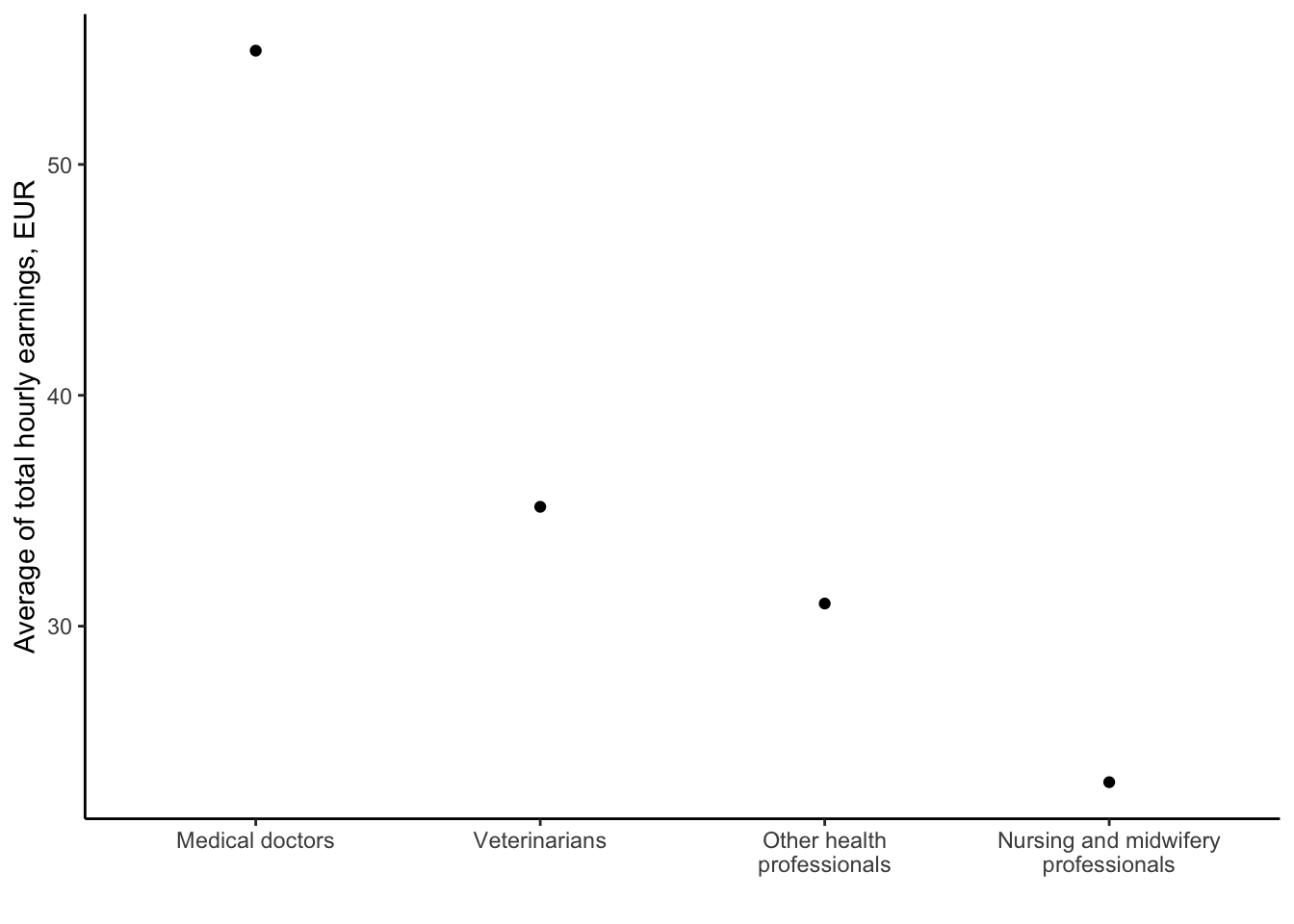
Market imperfections?
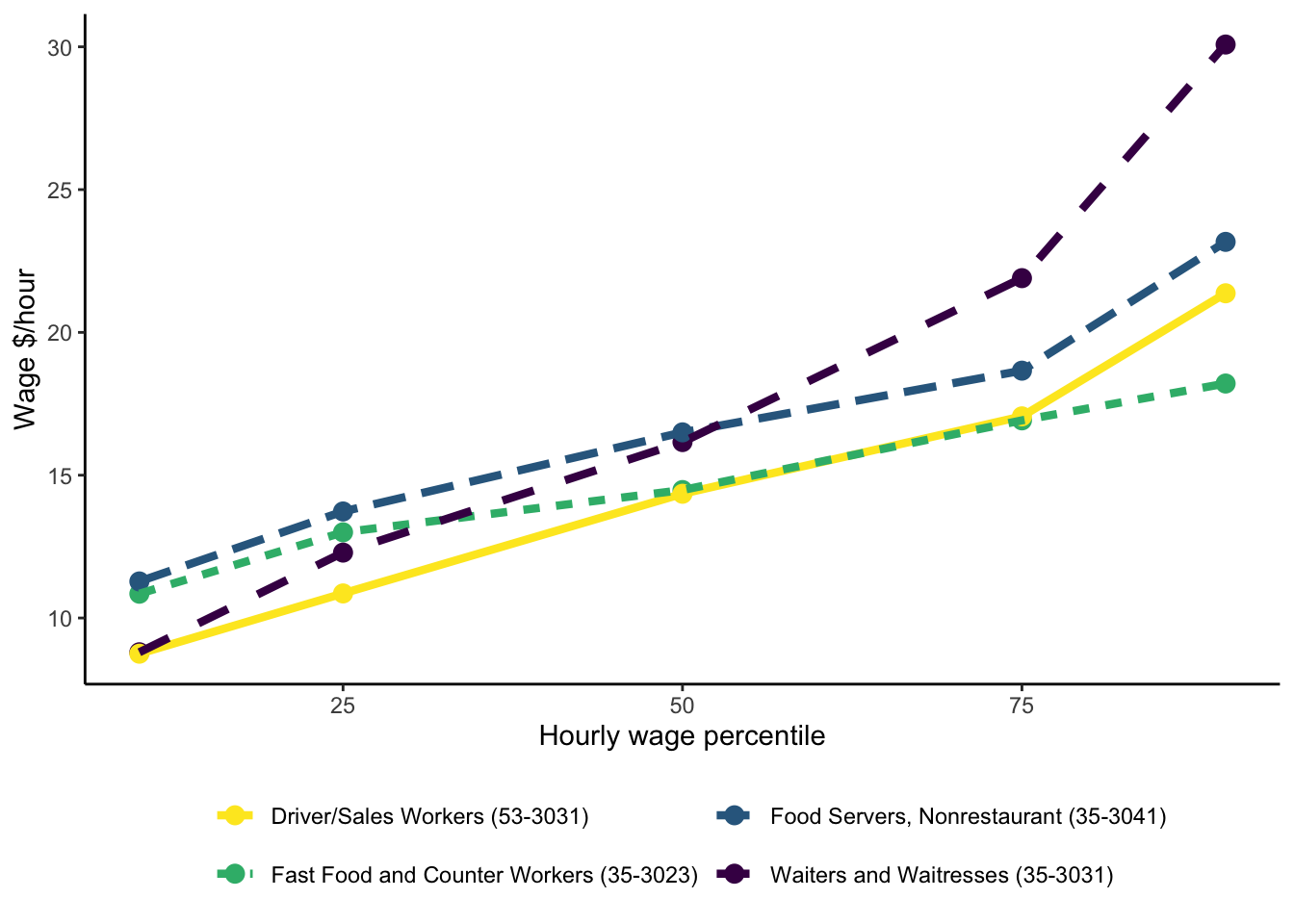
Another possible explanation for variation in observed wages could be that wages in some sectors are affected by market imperfections.
First, we could think about market power. When employer is operating as a monopsonist (sole buyer of labour), then wages in that sector of the economy may be dampened. For example, compare the distribution of wages between workers in fast-food restaurants, waiters and food servers. Fast-food sector is more likely to contain large fast-food chains, which may be operating as monopsonists. (However, note that this can be very difficult to show). We see that hourly wages of fast-food workers are typically lower and more compact.
Second, market imperfections may also arise due to asymmetric information. When employers don’t observe exact productivity types of their workers, they will need to pay wages based on some kind of average information. It means that these wages may be above marginal productivities for some workers, and below - for others. It is again difficult to find a direct evidence in the data that we could attribute to this phenomenon. As a proxy, we could look at the wages of workers in food sector to those of food delivery workers (yellow line in the above figure). It may be interesting because productivity of delivery workers may be easier to measure, especially nowadays with delivery apps and rating scales so ubiquitous. In particular, interesting comparison is between wages of delivery workers and fast-food counter workers. We see that lowest wages of delivery workers are below the lowest wages of fast-food counter workers, and highest wages are above. This could point to the possibility that wage scheme of fast-food counter workers suffer from imperfect information.
Of course, there are many things happening at the same time, and none of the graphs above isolate one specific channel. But they give us some ideas of what might be happening.
We will now study the impact of compensating differentials and market imperfections on wages. In the end, we will review some of empirical papers that attempt to estimate the importance of different channels.
Perfect competition
Jobs of equal difficulty
Production function
Workers supply
Linear worker utility
Equilibrium
We begin with a very simple model.
First, we specify single-input production function
On the worker side, we also have a very simple case with utility that only depends on consumption and disutility of job
Since we know the distribution of
Jobs of equal difficulty
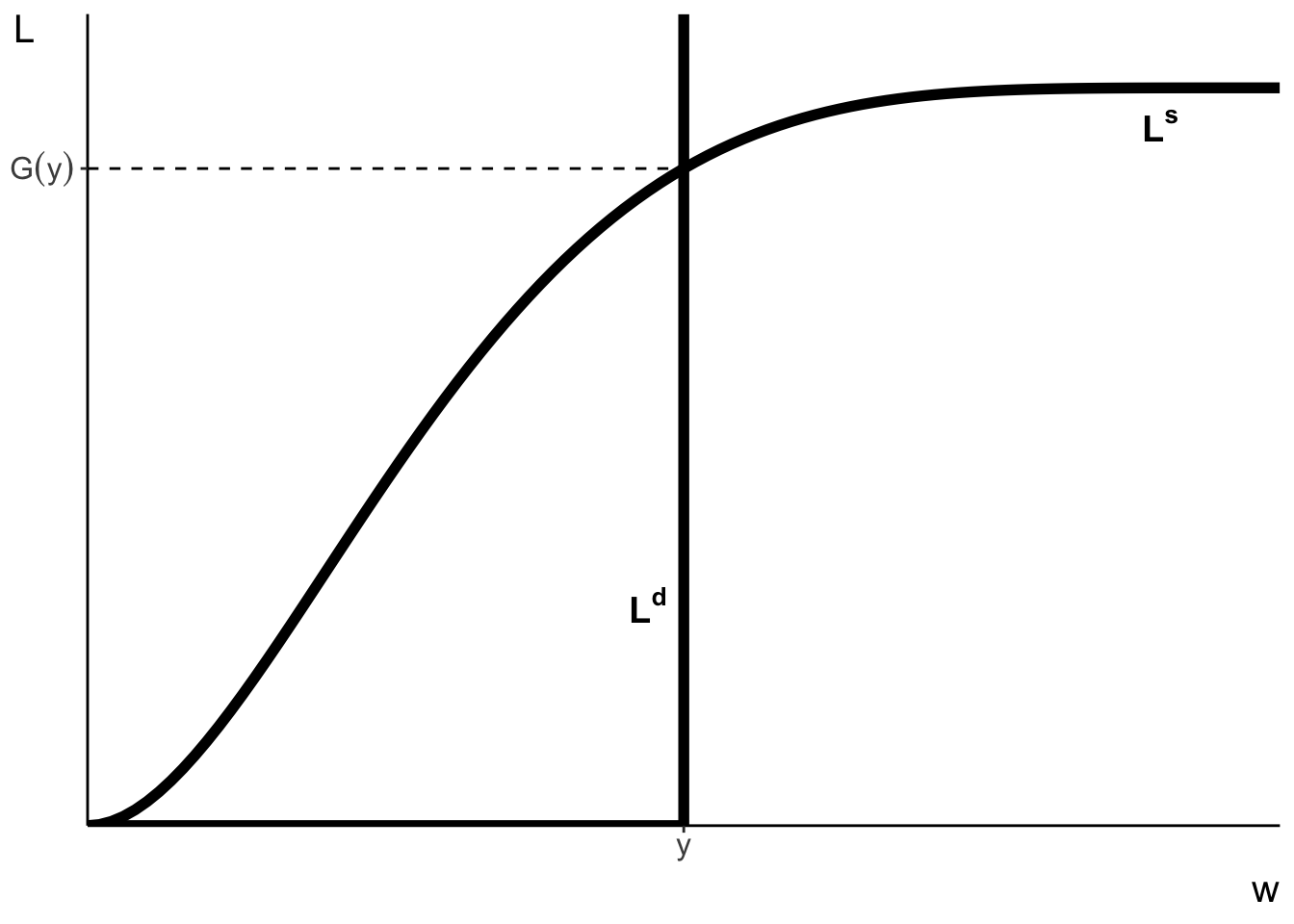
We can also illustrate the equilibrium in graphical form. The figure above plots the optimal labour demand and labour supply curves as a function of wages.
As we said earlier, at any wage
The labour supply curve is basically just the CDF curve at respective wages. We know that the CDF curve is increasing and bounded between 0 and 1.
It is easy to see that labour supply and demand curves cross only once at a point
This is a super simple case where firms and workers don’t really make any decisions. However, it helps to setup the environment where we can now explore the role of job characteristics.
Jobs of varying difficulty
Continuum of jobs with varying difficulty
Productivity
Compensating wage differentials:
Now, we can consider a case where jobs do vary in the type and difficulty of tasks they involve. We assume that all relevant characteristics of the job can be summarised in a uni-dimensional variable
Important addition is that now the characteristic
The worker chooses which job to supply her labour to. Once she has chosen a job with characteristic
To make sense of this condition imagine what happens if she works at jobs with slightly lower
We can also describe the relationship between
Meaning that higher is the disutility parameter of the worker
Notice also that wages are increasing in difficulty
Jobs of varying difficulty
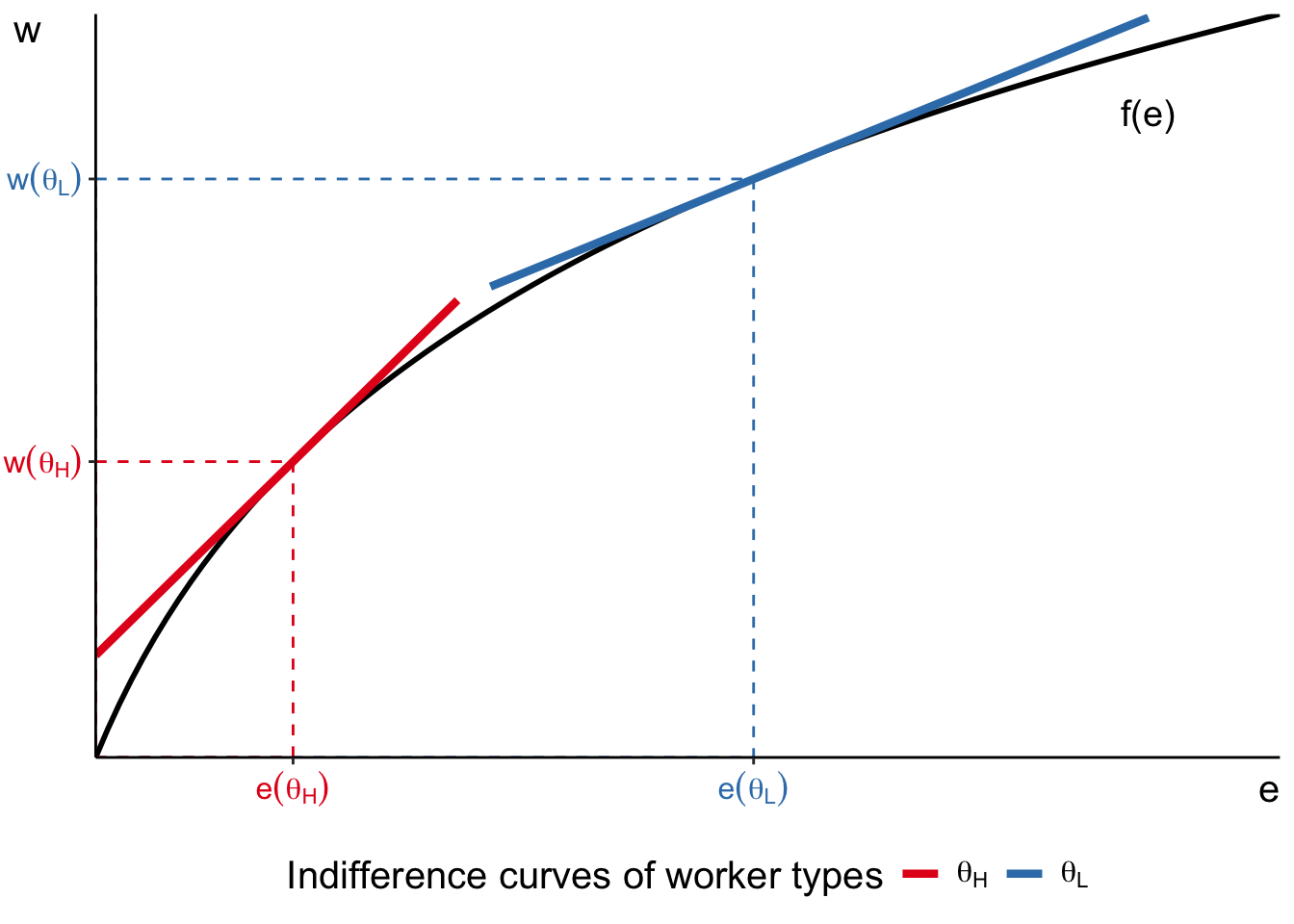
We can illustrate the optimality conditions graphically in the
Recall that we assumed a simple linear utility function. It implies that indifference curve between
And we can also plot the production function in the same space. It is increasing and concave.
Now, consider two workers: one with low
This is exactly what the optimality condition equations are describing. Workers with
Workplace safety regulation
At baseline worker of type
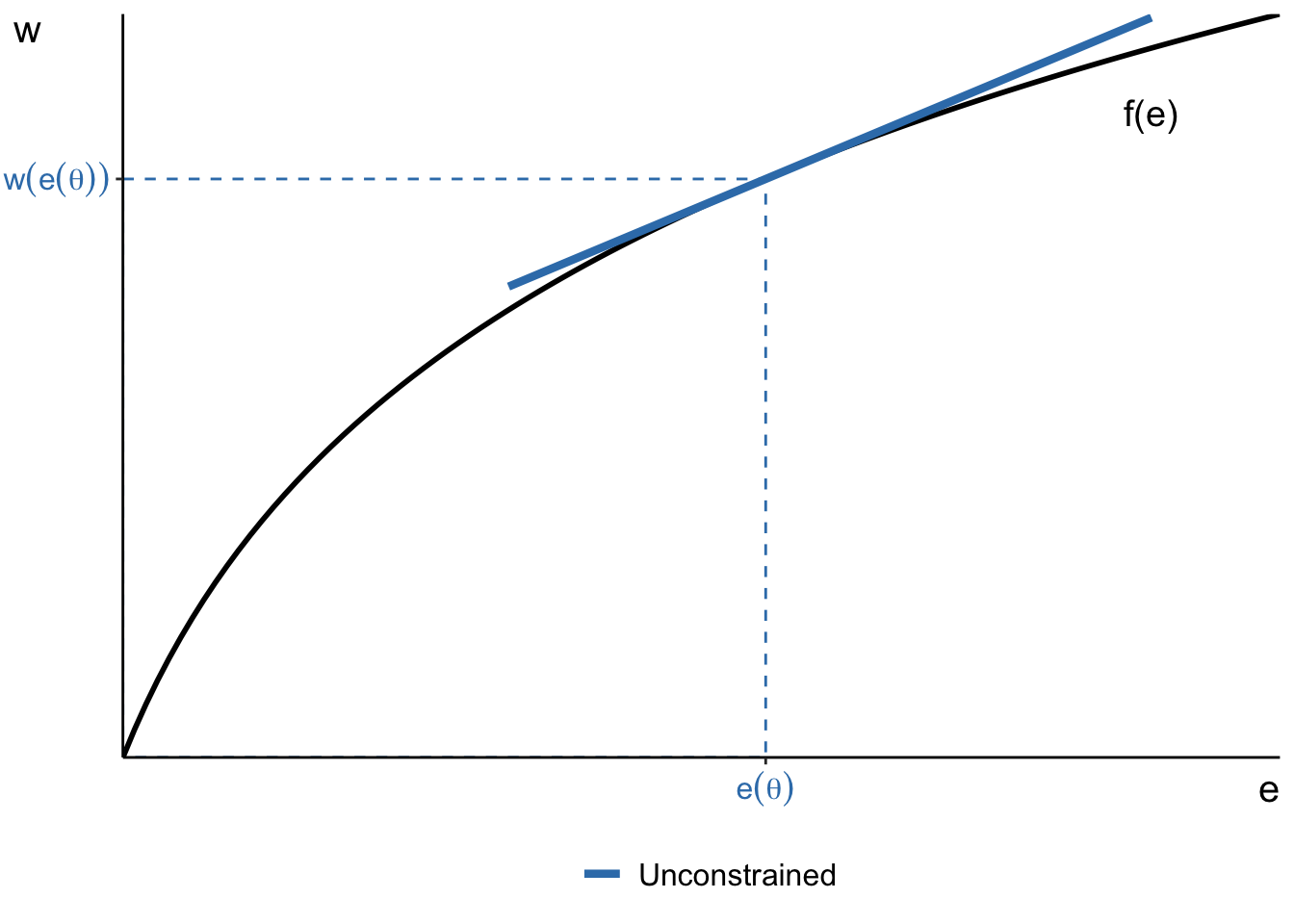
We can also analyse the predictions of this model when the policy makers put in place workplace safety regulations.
First, let’s re-draw the optimal choice of job and equilibrium wage of a worker with
How can we illustrate safety regulation such that no work can be of difficulty
Workplace safety regulation
Limit on job difficulty
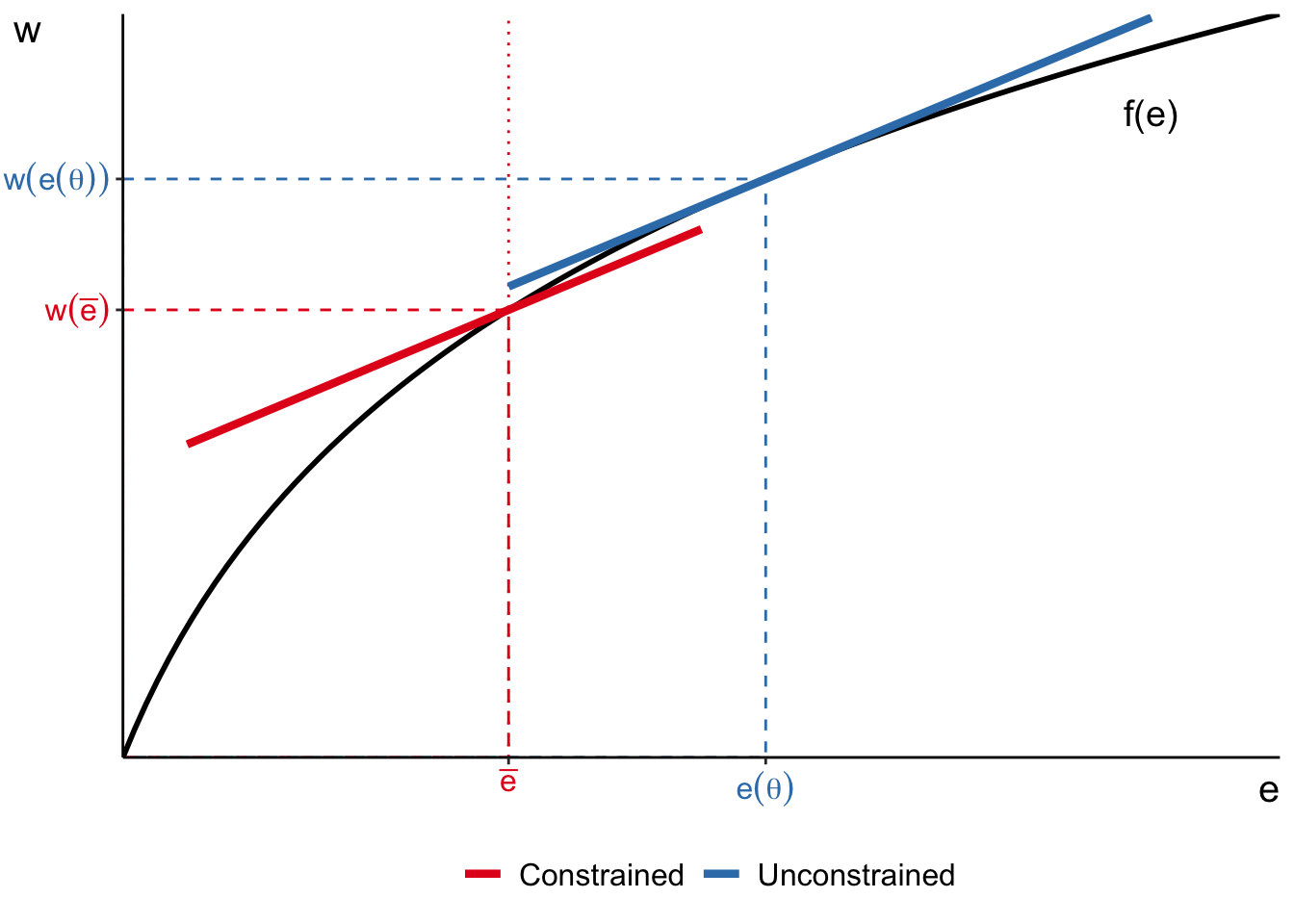
Now, the jobs cannot be more difficult than
Notice that under perfect competition, having workplace safety regulation makes workers worse off! Because under perfect competition, workers have full information about perils of job and own skills, and choose accordingly. For example,
However, the equilibrium with
Perfect competition: summary
- Even under perfect competition, wages and labour supply decisions of workers depend on
- abilities of workers: more productive workers earn higher wages
- characteristics of jobs: more difficult jobs offer higher wages
- Efficient allocation of resources
- part of the population may choose not to work because jobs are not attractive enough
Imperfect competition
Barriers to entry: monopsonistic employer
Start from baseline model
- Continuum of workers
- Monopsonistic employer
Equilibrium wage
Equilibrium employment
Labour markets may not operate under perfect competition. In this case, wages do not only reflect marginal productivities and individual preferences.
One example of imperfect competition is when the assumption of free entry fails. For example, workers may not be able to choose jobs and firms because there is only one employer in her labour market. Barriers to entry may arise due to geographic isolation or licencing costs of heavily-regulated jobs.
We will continue with a simple linear utility function of the worker. For simplicity, we again assume that
On the firm side, we again assume constant marginal product of labour
Monopsonistic wage derivation (FOC)
Since
This means that
We can use this expression to define monopsony power as the ratio between marginal productivity (i.e., wage under perfect competition) and monpsony wage,
Barriers to entry: monopsonistic employer
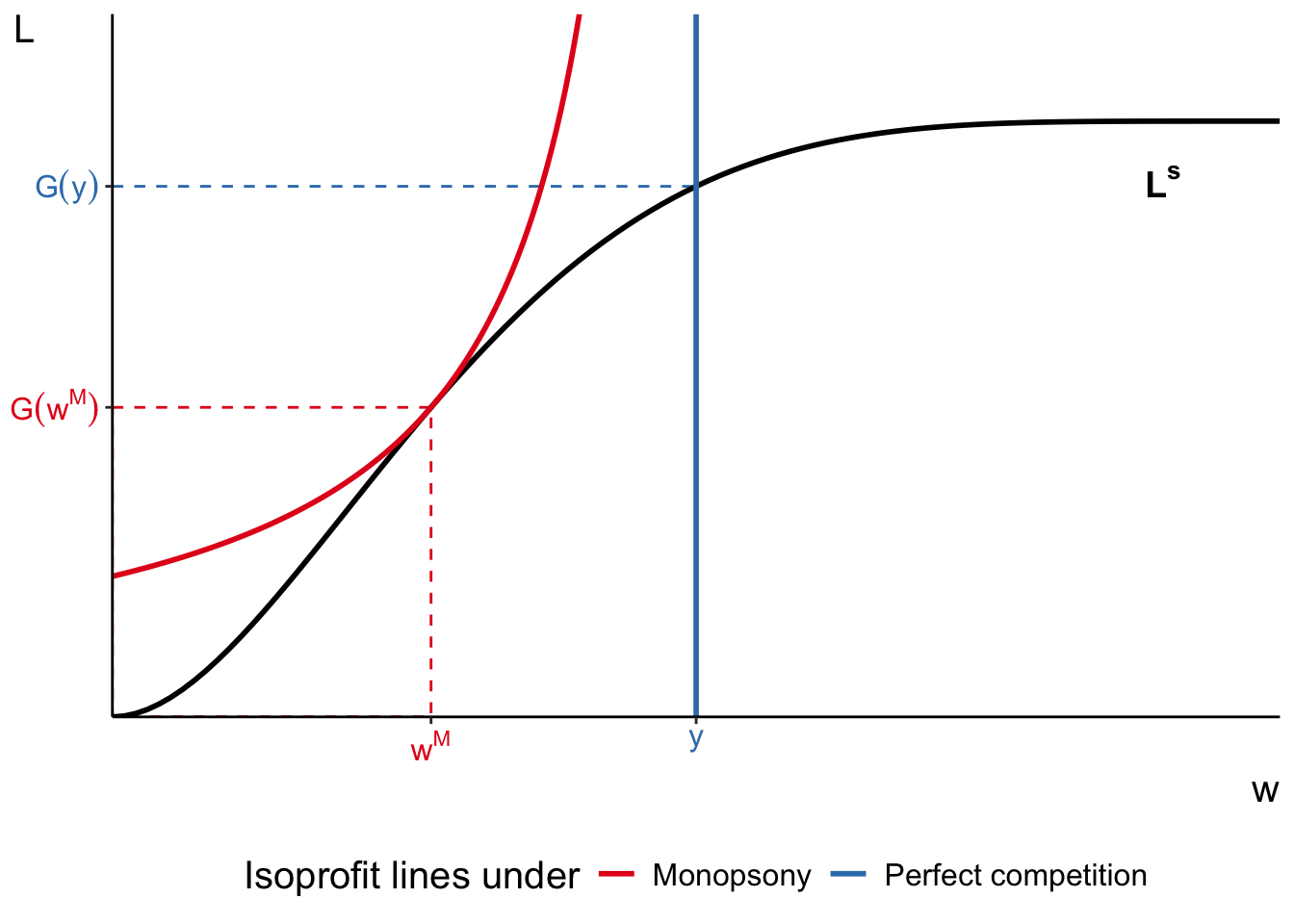
If we represent this labour market in graph, then the monopsonistic equilibrium is found at the point of tangency between the labour supply curve and isoprofit line. We can see clearly that
Monopsonistic employer and minimum wage
What happens if government mandates min wage

Monopsonistic employer and minimum wage
Equilibrium employment and wages both rise!

Recall from lecture 3, we discussed briefly how minimum wages can have positive effect on employment in monopsonistic labour markets. We can use our current setting to understand why.
Assume that the government mandates
Can you describe how the equilibrium changes in this market when
Imperfect information and adverse selection
- Workers are now described by their ability
- produce
- enjoy leisure utility
- produce
- Workers enjoy utility
- Firms now offer identical jobs
- Firms do not observe true
Another form of market failure that can affect wage setting arises due to imperfect information.
We have seen in the previous lecture the case where workers have imperfect information about jobs. There workers could end up with different wages even though their marginal productivities and preferences are identical. We also briefly discussed the implications of an extension where firms are added to the search model. In particular, one of the implications was that firms were willing to offer higher wages when competition for workers is high. This could also be reflected in the wages of a worker with longer working history being much higher than wages of a new entrant, even if their marginal productivities are exactly the same.
This time we will consider what happens to the firm behaviour when they don’t have enough information about workers.
In this model, workers have different abilities
Can you describe the equilibrium in this model under perfect perfect competition and full information?
Firms now offer identical jobs (
Imperfect information and adverse selection
Equilibrium is described by a pair
- all workers with
- firms hire all workers ready to work at
We can graphically illustrate the equilibrium by plotting
The FOC of the firm problem is
That is, equilibrium wage is equal to expected marginal productivity of workers conditional on them being ready to work at
A worker of type
Therefore, the equilibrium labour supply in the economy is
It also means that average production at firm is
Imperfect information and adverse selection
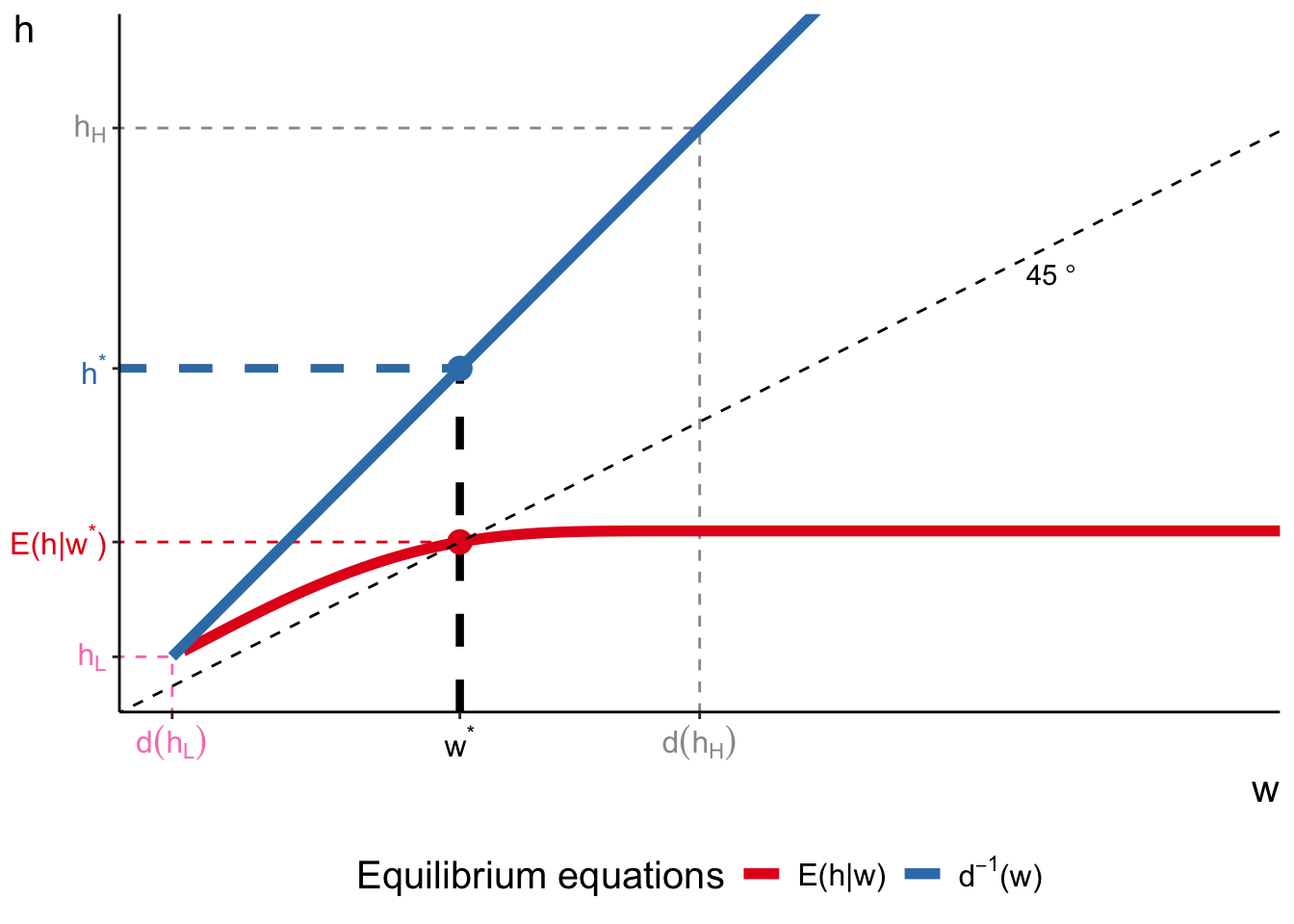
Here, we represent the equilibrium in
First, we can draw for every possible
Second, we can also draw
You can now clearly see how imperfect information changes equilibrium. All workers of type
Another important observation is that pooling equilibrium will exclude the most productive workers from the labour market. All workers of type
Finally, let’s assume that worker types are bound between
There exists another, separating equilibrium, where firms can use costly unproductive signals to discern worker types. In that case, the firm is able to offer wage schedule equivalent to that under full information (pay each worker their marginal productivity). In this case, workers must bear the cost of the signal.
Imperfect competition: summary
Wages no longer reflect productivity differences alone
- monopsonistic employer: equilibrium wages and employment
- innovation and mobility costs (Cahuc 2004, ch 5.2)
- trade unions (Cahuc 2004, ch 7)
- Workers and firms may have incomplete information about each other
- In the example, where firms do not know true worker productivities
- adverse selection: most productive workers stay unemployed
- Last lecture, workers have imperfect information about jobs
- with on-the-job search and endogenous wages,
- with on-the-job search and endogenous wages,
Empirical evidence
Estimates of compensating differentials
Regression of wage
Early estimates biased by
- unobserved heterogeneity in productivity
- unobserved heterogeneity in preferences
For example,
Ideally,
- Workers may rank job characteristics differently: some workers might like jobs with high physical strength requirements, and others - not.
- This means that there may not be universally agreed ranking in
- Workers may differ in their productivities, which allows them to choose jobs of lower difficulty while still enjoying higher income (see illustration on next slide).
Estimates of compensating differentials
Unobserved heterogeneity in productivity
Consider again model with varying
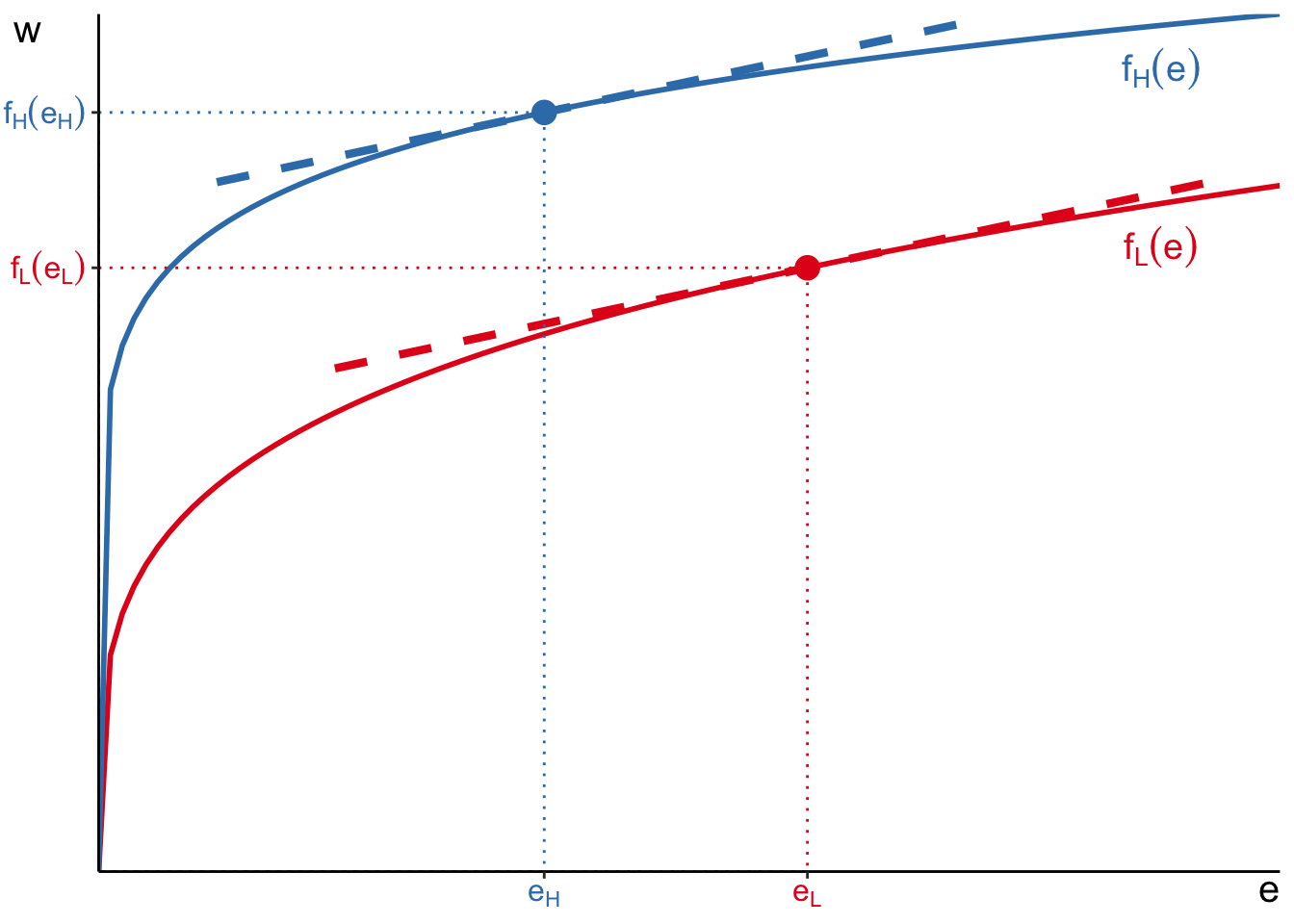
Let’s consider again the model with jobs of varying difficulty. Imagine that we have two workers with identical disutility parameter
The optimal job choice of workers is at the point where their marginal productivities are equal to their disutility parameter
Workers only differ in their productivities. Let’s say that red worker is less productive at every job and blue worker is more productive at every job. It means that marginal productivity curve of the blue worker is higher. Therefore, the optimal job choice and wages of red and blue workers will be different and depend on the curvature of utility and productivity functions.
The case illustrated above suggests that more productive guy choose a less difficult job and earns higher wages. So, even if both of these workers have same
- The optimal effort
- Worker
- Since
- Worker
- Note that compensating differentials still holds in this illustration.
- if you fix the productivity level and allow workers to differ by
- if you fix the productivity level and allow workers to differ by
- Hence, failing to account for individual heterogeneity in productivity biases the slope of
Estimates of compensating differentials
Hwang, Reed, and Hubbard (1992)
| Thaler and Rosen (1976) | Hwang et al. (1992) | |
|---|---|---|
| Age | 3.890 | 4.500 |
| (0.800) | ||
| Age |
-0.048 | -0.096 |
| (0.009) | ||
| Education | 3.400 | 4.870 |
| (0.550) | ||
| Risk | 0.035 | 0.302 |
| (0.021) | ||
| R2 | 0.41 | 0.31 |
| Price of life saved (in years of wage) | 26.54 | 227.67 |
| Mean weekly wage | 132.65 | 132.65 |
- Early estimates from cross-sectional data taken from Thaler and Rosen (1976)
- According to these estimates, reducing the risk of death is worth 26.54 years of work at average wage.
- Hwang, Reed, and Hubbard (1992) illustrate how these estimates suffer from unobserved heterogeneity (both in preferences and productivities)
- Then Hwang, Reed, and Hubbard (1992) make assumptions about model parameters that capture these heterogeneities based on existing evidence. That is, these parameters should closely approximate real labour markets.
- Under these parameter assumptions, the price of life saved rises to 227.67 years of work at average wage!
Estimates of compensating differentials
Bonhomme and Jolivet (2009)
Job search frictions: even small costs enough MWP
| Finland | ||
|---|---|---|
| MWP | Wage differentials | |
| Type of work | 0.016 | 0.107 |
| (0.180) | (0.040) | |
| Working conditions | 0.070 | 0.004 |
| (0.080) | (0.030) | |
| Working times | -0.016 | 0.048 |
| (0.070) | (0.040) | |
| Distance to work | 0.162 | -0.031 |
| (0.060) | (0.040) | |
| Job security | 0.537 | 0.068 |
| (0.220) | (0.040) | |
- Searching and changing jobs may be too costly, so workers may not switch to a better job if the benefit is too small
- There may be incomplete information about jobs, so workers do not know fully which job is optimal
- In addition, Bonhomme and Jolivet (2009) allow for unobserved heterogeneity in productivities and preferences
- The authors show that
- in cross-sectional wage regressions, even with very small job search costs estimated wage differentials have no resemblance to underlying individual preferences for amenities (MWP)
- dynamic regressions based on job changes can reflect individual preferences for amenities, but only if all job changes were voluntary
- even a small share of involuntary changes “makes preferences almost invisible” in estimates of wage differentials
Estimates of compensating differentials
Lamadon, Mogstad, and Setzler (2022)

- Lamadon, Mogstad, and Setzler (2022) aim to quantify the importance of imperfect competition in explaining the labour market patterns in the US.
- They do so by quantifying the amount of rents firms and workers extract from ongoing employment relationships
- To be able to estimate the rents, the model needs to allow heterogeneity in preferences for non-wage amenities
- As a result, also can estimate the magnitude of compensating differentials that describe the data
- The authors report sizeable differentials
- on average, firms have to pay 10-30% higher wages to compensate for less attractive jobs
- interesting that this number is increasing in worker productivities!
Determinants of wage inequality
Taber and Vejlin (2020)
Estimate importance of four channels of wage heterogeneity:
- Roy model: comparative advantage in skill for job
- Job search model: search and mobility costs
- Compensating differentials model: preferences for non-wage attributes
- Human capital model: boost productivity while working
- Roy model: choose jobs according to absolute and comparative advantage in individual skills
- Job search model:
- workers may not have met the firm/job that is most optimal to them
- workers may not have enough bargaining power at the optimal firm because they don’t have good enough alternative job offers
- workers may not have met the firm/job that is most optimal to them
- Compensating differentials: accept lower wages for a job that worker enjoys more
- Human capital: accumulate more human capital (that raises productivity) while working
Separating between the different determinants of wage inequality is important from the policy perspective too.
- If most of inequality comes from compensating differentials (i.e., individual preferences), we may not want to correct for it
- If wage inequality is mostly explained by differences in pre-market skills (Roy model), then policies targeted at childhood development, schools and education system are appropriate.
- If wage inequality is driven by job search frictions, then optimal policies should try to correct for these issues (for example, online job portals, standardised CV screenings, blind auditions etc)
- If wage inequality is mostly due to human capital accumulation while working, then we may want to implement policies that make on-the-job training more accessible, better structured, more targeted, etc.
Determinants of wage inequality
Taber and Vejlin (2020)
| A | Variance |
|---|---|
| Total | 0.104 |
| No learning by doing | 0.096 |
| No monopsony | 0.093 |
| No premarket skill variation across jobs | 0.05 |
| No premarket skill variation at all | 0.008 |
| No search frictions | 0.007 |
| B | Variance |
|---|---|
| Total | 0.104 |
| No learning by doing | 0.096 |
| No monopsony | 0.093 |
| No search frictions | 0.086 |
| No premarket skill variation across jobs | 0.049 |
| No premarket skill variation at all | 0.007 |
| C | Variance |
|---|---|
| Total | 0.104 |
| No learning by doing | 0.096 |
| No monopsony | 0.093 |
| No nonpecuniary aspects of jobs | 0.087 |
| No premarket skill variation across jobs | 0.048 |
| No premarket skill variation at all | 0.006 |
| D | Variance |
|---|---|
| Total | 0.104 |
| No learning by doing | 0.096 |
| No monopsony | 0.093 |
| No nonpecuniary aspects of jobs | 0.087 |
| No search frictions | 0.061 |
| No premarket skill variation across jobs | 0.047 |
- The relative importance of each factor is measured by the reduction in variance of log wages after removing that factor.
- Therefore, the importance estimates depend on the order in which different factors are removed
- In all four cases, human capital accumulation on the job and monopsony power are removed first since these are expected to be small in magnitude based on existing studies.
- In all four scenarios, premarket variation in skills is by far the most important factor, explaining between 50-80% of variation in wages.
- Search frictions explain between 1-26% of wage variations depending on the order of elimination.
- In these scenarios, compensating differentials do not explain much of wage inequality.
- However, in Table VII Taber and Vejlin (2020) show that compensating differentials are extremely important for explaining utility variations and job choices!
Determinants of wage inequality
Summary
- Wage dispersion can be related to
- individual heterogeneity in productivity/job tastes
- heterogeneity in job conditions
- monopsonistic employers forcing wage
- seniority premium with incomplete information and labour market costs
- Incomplete information can also drive most productive workers out
- Differentiating between different channels in data can be challenging
Next lecture: Human Capital on 10 Sep
